the Creative Commons Attribution 4.0 License.
the Creative Commons Attribution 4.0 License.
Sensitivity of climate–chemistry model simulated atmospheric composition to the application of an inverse relationship between NOx emission and lightning flash frequency
Francisco J. Pérez-Invernón
Francisco J. Gordillo-Vázquez
Heidi Huntrieser
Patrick Jöckel
Eric J. Bucsela
Lightning-produced nitrogen oxides (LNOx = LNO + LNO2) are an important source of upper-tropospheric ozone. Typical parameterizations of LNOx in climate–chemistry models introduce a constant amount of NOx per flash or per flash type. However, recent satellite-based NO2 measurements suggest that the production of LNOx per flash depends on the lightning flash frequency. In this study, we implement a new parameterization of LNOx production per flash based on the lightning flash frequency in a climate–chemistry model to investigate the upper-limit implications for the chemical composition of the atmosphere. We find that a larger production of LNOx in weak thunderstorms leads to a larger mixing ratio of NOx in the lower and middle troposphere, as well as to a lower mixing ratio of NOx in the upper troposphere. The mixing ratios of O3, CO, HOx, HNO3, and HNO4 in the troposphere are influenced by the simulated changes in LNOx. Our findings indicate a larger release of nitrogen oxides from lightning in the lower and middle atmosphere, producing a slightly better agreement with the measurements of tropospheric ozone at a global scale. In turn, we obtain a small decrease in the lifetime of methane and carbon monoxide, ranging between 0.7 % and 3.4 %.
- Article
(18210 KB) - Full-text XML
-
Supplement
(36327 KB) - BibTeX
- EndNote
Nitrogen oxides (NOx = NO + NO2) produced by lightning in the upper troposphere (Zeldovich et al., 1947) are about 6 times more efficient in driving ozone production than anthropogenic NOx emissions, producing about 100 molecules of ozone per molecule of lightning-produced NOx (LNOx) (Schumann and Huntrieser, 2007). Thus, LNOx affects the oxidizing capacity of the atmosphere and the tropospheric budget of carbon monoxide and methane (Wu et al., 2007; Murray et al., 2012; Gordillo-Vázquez et al., 2019).
The global production of LNOx is between 2 and 8 Tg (N) yr−1, which accounts for approximately 10 % of the global NOx sources. In the tropics, LNOx is responsible for around 20 % of the total NOx production (Schumann and Huntrieser, 2007, and references therein). Moreover, the LNOx production efficiency (PE) per lightning flash shows a large variability between different regions and thunderstorms (e.g., Pickering et al., 2016; Bucsela et al., 2019; Allen et al., 2019, 2021; Zhang et al., 2022; Pérez-Invernón et al., 2022a). In particular, systematic retrievals of LNOx from the Ozone Monitoring Instrument (OMI) by Bucsela et al. (2019) and Allen et al. (2019) and from the Sentinel-5P TROPOspheric Monitoring Instrument (TROPOMI) by Allen et al. (2021) reported an inverse relationship between flash rates and LNOx PE per flash. Bucsela et al. (2021) reported a new evaluation of TROPOMI-based LNOx PE estimations by using Geostationary Lightning Mapper (GLM) lightning measurements and a new set of atmospheric chemistry simulations to estimate the effect of the background NOx in the computations. According to Bucsela et al. (2021), the relationship between the production of LNOx PE and the lightning flash frequency could be weaker than the relationship previously reported by Bucsela et al. (2019) for weak and medium-activity thunderstorms (thunderstorms with less than 3000 flashes per hour and degree). Studies based on airborne measurements found a proportional relationship between flash length and LNOx PE per flash (Wang et al., 1998; Stith et al., 1999; Schumann and Huntrieser, 2007; Huntrieser et al., 2008). The inverse relationship between the length of lightning channels and the frequency of lightning occurrence in storms can reconcile these measurements (Bruning and MacGorman, 2013). Recently, Pérez-Invernón et al. (2023b) and Pickering et al. (2024) estimated LNOx PE per flash by combining Lightning Mapping Array (LMA) data with satellite- and aircraft-based NOx measurements, respectively. They found that thunderstorms with larger lightning rates produce shorter flash channel lengths and lower LNOx PE per flash, confirming previous results.
Lightning parameterizations in climate–chemistry models define the emissions of LNOx by lightning as a total number of NOx molecules per flash, sometimes distinguishing between CG (cloud-to-ground) and IC (intra-cloud) lightning strikes by a factor of 10 (Price et al., 1997; Allen and Pickering, 2002; Tost et al., 2007; Murray et al., 2012; Jöckel et al., 2016; Gordillo-Vázquez et al., 2019; Luhar et al., 2021; Pérez-Invernón et al., 2023a) or between tropical and extratropical regions (Murray et al., 2012). The parameterization of lightning and LNOx production has a substantial impact on the global ozone burden. Specifically, these parameterizations can simultaneously lead to significant overestimates and underestimates of tropospheric ozone mixing ratios in different regions. For instance, Grewe et al. (2001) and Allen and Pickering (2002) noted that commonly used lightning parameterizations based on cloud top height (CTH) can result in an underestimation of tropospheric ozone mixing ratios in the Southern Hemisphere and, conversely, an overestimation in the Northern Hemisphere. Therefore, they developed a new lightning parameterizations that produce a higher lightning flash frequency over the ocean (Tost et al., 2007). More recently, Luhar et al. (2021) proposed a modification of the lightning parameterization based on the CTH by Price et al. (1997) to partially address this disagreement. The new lightning parameterization by Luhar et al. (2021) led to a larger production of LNOx over the ocean, producing more tropospheric ozone in the Southern Hemisphere, which agrees better with observations. However, their new lightning parameterization produced an enhancement of tropospheric ozone in the Northern Hemisphere, in disagreement with ozone measurements.
Previous studies have proposed various parameterizations for LNOx production to introduce a certain level of variability and investigate the sensitivity of tropospheric chemical composition (Koshak et al., 2014; Kang et al., 2019; Wu et al., 2023). However, so far there have been no sensitivity studies of climate–chemistry models to lightning NOx production parameterizations based on lightning frequency. In this study, we explore the differences in the chemical composition of the atmosphere by using a parameterization of LNOx production based on lightning frequency (Bucsela et al., 2019, Fig. 11c) compared to imposing a constant amount of NOx molecules emitted per CG lightning strike and 1 order of magnitude lower for the emissions from IC lightning flashes. Bucsela et al. (2019) reported that LNOx PE decreases by 1 order of magnitude if the flash frequency increases by 2 orders of magnitude.
2.1 Lightning NOx production parameterization
Firstly, the relationship between the LNOx production efficiency (PE) and the flash rate, as shown in Bucsela et al. (2019, Fig. 11c), is fitted to the following equation:
where PE is the production efficiency in moles of NOx per flash, f is the flash rate in kilo-flashes per hour, and a and b are dimensionless fitting coefficients with values of 0.503 and 8.01, respectively. The goodness of fit for this relationship is characterized by R2 = 0.995.
Price and Rind (1992)Price et al. (1997)Grewe et al. (2001)Price et al. (1997)Luhar et al. (2021)Price et al. (1997)Price and Rind (1992)Price et al. (1997)Price and Rind (1992)Bucsela et al. (2019, Fig. 11c)Grewe et al. (2001)Price et al. (1997)Grewe et al. (2001)Bucsela et al. (2019, Fig. 11c)Luhar et al. (2021)Price et al. (1997)Luhar et al. (2021)Bucsela et al. (2019, Fig. 11c)Table 1Overview of the performed simulations from 1 January 2000 to 1 January 2008. The subscript indicates the lightning parameterization: P represents Price and Rind (1992), G represents Grewe et al. (2001), and L represents Luhar et al. (2021). The variables that serve as a proxy for the lightning flash frequency are the cloud top height (CTH) and the upward flux of mass (Mup). The scaling factors to get ∼ 48 flashes per second during 2000 are included.

2.2 Climate–chemistry model and simulation set-ups
We employ the ECMWF–Hamburg (ECHAM)/Modular Earth Submodel System (MESSy version 2.55) Atmospheric Chemistry (EMAC) model (Jöckel et al., 2016) to perform three pairs of 8-year simulations using three different flash frequency parameterizations, with two different LNOx schemes each. The simulations are conducted at a T42L90MA resolution, utilizing a quadratic Gaussian grid with box dimensions of approximately 2.8° × 2.8° in latitude and longitude. The model set-up covers 90 vertical levels that extend up to the 0.01 hPa pressure level, and a time step length of 720 s is employed (Jöckel et al., 2016). The lightning frequency is calculated at every time step and box by using the lightning parameterizations proposed by Price and Rind (1992), Grewe et al. (2001), or Luhar et al. (2021), being the latest modifications of the parameterization based on the CTH by Price and Rind (1992). In turn, we use scaling factors that ensure a global lightning occurrence rate of ∼ 48 flashes per second (Christian et al., 2003; Cecil et al., 2014). We refer to Pérez-Invernón et al. (2022b) for a detailed description of the performance of the parameterizations used in EMAC. In turn, we show the simulated annual spatial distributions of lightning flash density in Fig. S1 in the Supplement. LNOx is calculated by using a modified version of the LNOX submodel of MESSy (Tost et al., 2007). Originally, the LNOX submodel imposes a constant amount of NOx molecules emitted per flash that can be different or equal for CG and IC lightning based on Price et al. (1997). As a second step, the LNOx molecules are vertically distributed by following a prescribed vertical profile that can vary latitudinally or between land and ocean, following the C-shaped vertical profiles reported by Pickering et al. (1998). We modify the LNOX submodel to include the LNOx parameterization reported by Bucsela et al. (2019, Fig. 11c) and derived in Eq. (1).
We conduct the simulations using the quasi chemistry–transport model (QCTM) approach (Deckert et al., 2011). The QCTM mode allows for the separation of dynamics and chemistry in order to operate the model as a chemistry–transport model. This means that minor chemical changes do not introduce noise by affecting the simulated meteorology. The overview of the performed simulations are listed in Table 1, including the meteorological variables that serve as a proxy for lightning flash frequency, the scaling factors to get ∼ 48 flashes per second during 2000, and the production of LNOx per flash and per year.
First, we perform three fully coupled free-running 8-year simulations (denoted BASE, where the subindex indicates the lightning flash frequency parameterization) from 1 January 2000 to 1 January 2008 to derive the forcings for the subsequent simulations. There is no consensus about the similarity or difference in the production of NOx per flash depending on the type of lightning (Schumann and Huntrieser, 2007; Gordillo-Vázquez et al., 2019). However, climate–chemistry simulations usually set different LNOx PE values for CG and IC lightning (Tost et al., 2007; Jöckel et al., 2016; Gordillo-Vázquez et al., 2019). In BASE simulations, we impose a production of 1112 mol per CG flash and 111.2 mol per IC flash, obtaining annual global emissions for LNOx of 5.66, 4.94, and 5.58 Tg (N) yr−1 for the lightning parameterizations by Price and Rind (1992) (subscript P), Grewe et al. (2001) (subscript G), and Luhar et al. (2021) (subscript L), respectively. These produced amounts per flash are based on the estimation of 6.7 × 109 J per CG flash, 0.67 × 109 J per IC flash, and 10 × 1016 reported by Price et al. (1997). We employ the same chemical set-up and chemical mechanism as detailed by Jöckel et al. (2016) for the RC1-base-07 simulations.
The second set of simulations, here referred to as control (or CTR) simulations, are similar to the BASE simulations in terms of lightning and LNOx parameterizations but using the radiative forcing fields from the BASE simulations, following the QCTM approach.
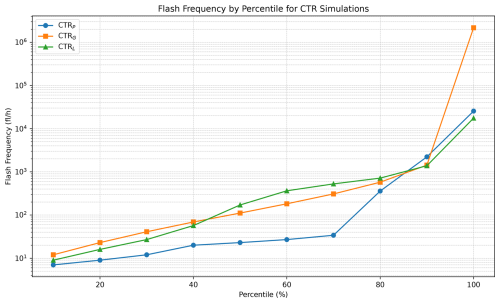
Figure 1Fraction of 2.8° × 2.8° in latitude and longitude boxes (in percentile) containing less than a given instantaneous flash frequency in flashes per hour (“fl/h”) from the CTR simulations.
At this point, we explore the applicability of Eq. (1) within our model. Equation (1) is derived from data aggregated over 1° × 1° latitude–longitude grid boxes, whereas the simulations will be conducted using a coarser resolution of 2.8° × 2.8° grid boxes. We check that the percentage of boxes that contain a flash frequency lower than a specified value in the simulation and in the gridded data of Bucsela et al. (2019, Fig. 11c) are comparable. The data in Fig. 1 show the total number of flashes per hour in the 2.8° × 2.8° latitude and longitude boxes from EMAC. These values were estimated by selecting all the boxes at every output time step of 720 s (13 566 603 total samples) from the CTR simulations for the year 2000. These data allow us to ensure that the use of the LNOx by Bucsela et al. (2019, Fig. 11c) is applicable in the LNOX submodel of MESSy. According to Bucsela et al. (2019), who used the World Wide Lightning Location Network (WWLLN) midlatitude lightning measurements corrected by the network's detection efficiency, nearly 90 % of the 1° × 1° boxes in latitude and longitude have flash rates lower than 2 kfl h−1 (where kfl represents 1000 flashes), while we find that 90 % of the 2.8° × 2.8° boxes in latitude and longitude have flash rates lower than 2225, 1432, and 1386 kfl h−1 (Fig. 1). In addition, comparison between the results of Bucsela et al. (2019, Fig. 11a) and Fig. 1 shows that the histogram of flashes per hour are roughly in agreement. This comparison of the instantaneous lightning frequency ensures the applicability of the LNOx parameterization by Bucsela et al. (2019, Fig. 11c) in the LNOX submodel.
The third set of simulations, here referred to as “LNOfs” simulations, is similar to the set of CTR simulations but using the LNOx parameterization reported by Bucsela et al. (2019, Fig. 11c) and scaling the total emissions of NOx from Eq. (1) to obtain the same total emissions of LNOx as in the CTR simulations.
We use three lightning flash frequency parameterizations and the same LNOx vertical profile (Pickering et al., 1998) in all the simulations to isolate the effect of the LNOx production parameterization on the chemical composition of the atmosphere. However, other lightning parameterizations (Tost et al., 2007) and vertical profiles of LNOx (Ott et al., 2010) can also be used, possibly producing slight variations in the results.
3.1 Total emissions of LNOx
We extract the global total (CG + IC) flash frequency and the total amount of LNOx at every output time step of 720 s during 2000 to estimate the global distribution of the produced LNOx per year from the CTR and LNOfs simulations. Figure 2 shows the mean daily data for June–July–August (JJA) of LNOx obtained from the CTR and LNOfs simulations, as well as the difference between them. We select the season JJA to facilitate the comparison with OMI-WWLLN-based measurements by Bucsela et al. (2019, Fig. 3). The LNOfs simulations predict a larger amount of LNOx over the tropical ocean, where thunderstorms have a lower lightning frequency than over land. In turn, the decrease in the production of LNOx is larger over land in tropical regions than in midlatitudes, as tropical thunderstorms are more active. The LNOfsP and LNOfsG simulations present a smoother distribution of the LNOx distribution over land than the CTRP and the CTRG simulations, with a significant decrease in the peak production of LNOx in North America. The difference of the land/ocean contrast of the production of LNOx between the CTRL and LNOfsL simulations is lower, because the parameterization by Luhar et al. (2021) detects more active thunderstorms over the oceans. In terms of the spatial distribution of LNOx production, the parameterizations based on lightning flash frequency rates reduces differences between the three employed lightning parameterizations. The differences between the LNOfs and CTR simulations can also be seen in the difference between the annual-averaged mixing ratios of NOx at the 800 hPa pressure level (Fig. 3). The new parameterization of the production of LNOx produces larger emissions of LNOx over oceans, except for the high-latitude oceanic regions in the LNOfsG simulation, where we obtain a smaller production of LNOx than in the CTRG simulation. The reason of this difference is that the lightning parameterization by Grewe et al. (2001) detects more active and sparse thunderstorms in these oceanic regions than the parameterizations based on the CTH (Tost et al., 2007, Fig. 2). The spatial distribution of the mean monthly LNOx obtained from the LNOfs simulations during 2000 is shown in Fig. S2. During 1 complete year, the parameterizations based on the CTH (LNOfsP and LNOfsL simulations) produce a smoother spatial distribution of LNOx, while the parameterization by Luhar et al. (2021) (LNOfsL simulation) produced relatively more LNOx over the oceans.
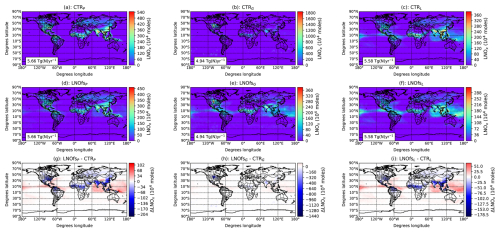
Figure 2Daily mean LNOx production (× 104 moles) in June–July–August (JJA) per 2.8° latitude × 2.8° longitude box obtained from the CTR (a–c) and the LNOfs (d–f) simulations. Panels (g–i) show the difference between CTR and LNOfs simulations. Note that the colour scales are different in each panel.
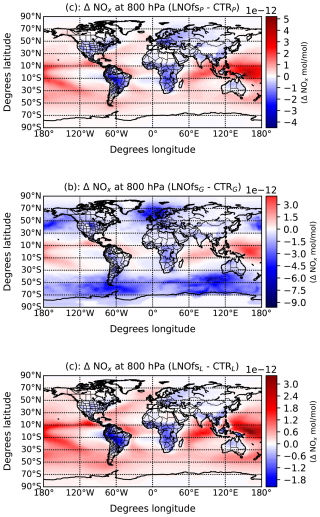
Figure 3Annually (2002–2007) and globally averaged differences in the mixing ratio of NOx between the simulations with the LNOx production based on the flash frequency (LNOfs) and the simulation with a constant quantity of LNOx production per flash (CTR) at the 800 hPa pressure level. The subscript indicates the lightning parameterization: P represents Price and Rind (1992), G represents Grewe et al. (2001), and L represents Luhar et al. (2021).
When comparing Fig. 2 to the mean daily LNOx emissions during JJA as reported by Bucsela et al. (2019, Fig. 3c), it becomes apparent that the LNOx parameterization based on the lightning frequency in the LNOfs simulations produces a spatial distribution of LNOx that aligns with space-based measurements more accurately (Bucsela et al., 2019, Fig. 3c) than the parameterization used in the CTR simulations. In particular, LNOx emissions over the ocean in the CTRP and CTRG simulations are too low to be noticeable compared to those over land, whereas they are larger in Bucsela et al. (2019, Fig. 3c). However, the LNOfP and LNOfsG simulations produce significant LNOx emissions over the oceans. Apart from that, the LNOfs simulations yield a spatial distribution of LNOx that exhibits a more homogeneous distribution in the tropics and midlatitudes compared to the CTR simulations.
3.2 Implications for the chemical composition of the troposphere
We compare the effect of LNOx on the chemistry of the troposphere between the CTR and LNOfs simulations. The spatial distributions of the annual global difference in the mixing ratio of the analysed chemical species at the 600, 400, and 200 hPa pressure levels between the LNOfs and CTR simulations are shown in the Supplement (Figs. S3–S11 in the Supplement). Figures 4 and 5 show the implications of using an LNOx parameterization based on the flash frequency in the annually and zonally averaged vertical profiles of NOx = NO + NO2, O3, CO, HOx = OH + HO2, HNO3, and HNO4. The vertical profile of N2O is not shown because the variations are negligible, as expected (absolute value lower than −0.005 %). We exclude plots of LNOfL from Figs. 4 and 5, because the influence of the new parameterization of LNOx production is spatially similar to that in the LNOfP simulations but reduced in absolute value (see Figs. S3–S11). The first column of Figs. 4 and 5 shows the annually and zonally averaged vertical profiles of the mixing ratios of these species from the CTRP simulation, the second column shows the differences in the profiles between the LNOfsP and the CTRP simulations, and the third column shows the differences in the profiles between the LNOfsG and the CTRG simulations.
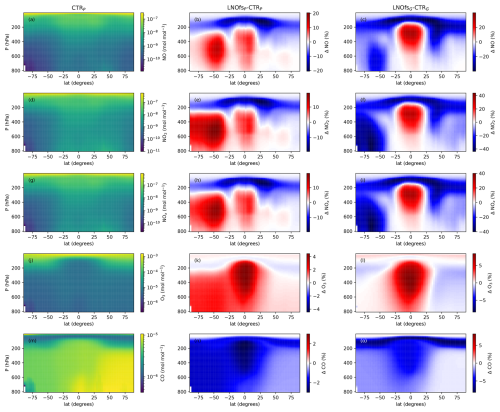
Figure 4First column: annually (2002–2007) and zonally averaged vertical profiles of the NO, NO2, NOx, O3, and CO mixing ratios for a simulation with a constant amount of LNOx production per flash (CTRP). Second column: differences (in %) between the annually and globally averaged mixing ratio of the chemical species from the simulation with the LNOx production based on the flash frequency (LNOfsP) and from the CTRP simulation. Third column: same as the first column but showing differences between the LNOfsG and CTRG simulations. The differences have been calculated as . The subscript indicates the lightning parameterization: P represents Price and Rind (1992) and G represents Grewe et al. (2001).
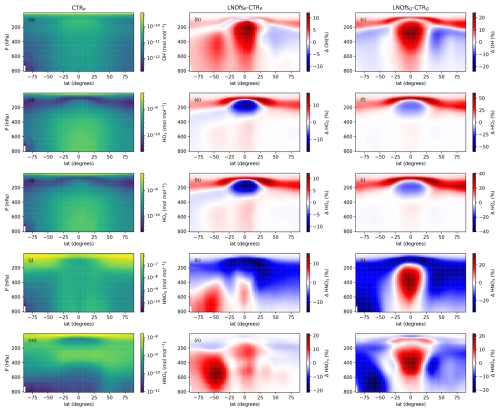
Figure 5First column: annually (2002–2007) and zonally averaged vertical profiles of the OH, HO2, HOx, HNO3, and HNO4 mixing ratios for a simulation with a constant amount of LNOx production per flash (CTRP). Second column: differences (in %) between the annually and globally averaged mixing ratio of the chemical species from the simulation with the LNOx production based on the flash frequency (LNOfsP) and from the CTRP simulation. Third column: same as the first column but showing differences between the LNOfsG and CTRG simulations. The differences have been calculated as . The subscript indicates the lightning parameterization: P represents Price and Rind (1992) and G represents Grewe et al. (2001).
The LNOfs simulations produce a larger mixing ratio of NO, NO2, and NOx in the middle level of the tropical troposphere (around 350 hPa in Fig. 4a–i) than the corresponding CTR simulations. However, the mixing ratio of NOx at altitudes above the 300 hPa pressure level is larger in the CTR simulations. In addition, Fig. 3 indicates that the difference at the 800 hPa pressure level is larger (more positive) over the ocean, where the flash frequency for thunderstorms is lower. In turn, the differences are lower (more negative) in the lightning chimneys over land in Africa, North America, and South America, where the flash frequency is notably higher. At the 200 hPa level (Figs. S9–S11a), the differences in NOx mixing ratio between the LNOfs and CTR simulations are negative in more areas. The spatial distributions of the NOx mixing ratios in Figs. S9–S11a indicate that the mixing ratio of NOx in the upper troposphere is lower in the LNOfs simulations, because more LNOx is emitted in weak thunderstorms (thunderstorms with a lower flash frequency) that are less efficient in elevating the LNOx to the upper troposphere. Therefore, the parameterization of LNOx production based on the flash frequency (LNOfs simulations) leads to a lower contribution of lightning to the sources of NOx of the upper troposphere compared to the CTR simulations. There are differences in the vertical profile of the variation of NOx between the LNOfsP and LNOfsG simulations, as can be seen by comparing Fig. 4h and Fig. 4i. Below the 500 hPa pressure level, the difference of the mixing ratio of NOx between the LNOfsP and CTRP simulations is positive, while the opposite is found when comparing the LNOfsG with the CTRG simulations. Nevertheless, these differences are small, both in absolute and in relative terms. We consider that these small differences are due to the fact that in the CTR simulations the LNOx depends on the ratio, while in LNOfs simulations both CG and IC produce the same amount of LNOx.
Differences in the NOx mixing ratio between the LNOfs and CTR simulations cause differences in other chemical species. The obtained differences in the mixing ratios of O3 between the LNOfs and CTR simulations are connected to the different spatial distributions of LNOx production. LNOx can produce or deplete O3 depending on the background mixing ratio of NOx caused by photochemistry (Crutzen, 1979; Schumann and Huntrieser, 2007; Liu, 1977; Verma et al., 2021). The NO directly produced by lightning can destroy O3 by chemical reaction (Levine et al., 1984)
and the resulting NO2 can produce atomic oxygen by photolysis following the reaction (Levine et al., 1984):
Finally, the produced atomic oxygen can increase the mixing ratio of O3 by interacting with a third body M (Levine et al., 1984) as
Overall, LNOx contributes to ozone depletion in regions with low background mixing ratio of NOx, such as over the tropical marine boundary layer. In turn, LNOx produces ozone in regions where the background mixing ratio of NOx is high, such as over the continents. Figure 4j–l illustrate that the LNOfs simulations lead to a larger mixing ratio of ozone in the lower and middle troposphere caused by a larger production of LNOx at these vertical levels, especially in the tropics. Additionally, the larger production of LNOx results in very low changes in the ozone mixing ratio in the upper troposphere, due to the presence of a high NOx background. At these higher altitudes, the efficiency of ozone production by NOx is larger, but the emitted LNOx is lower. Figures S6–S8b indicate that the larger positive change in the mixing ratio of O3 at the 400 hPa level is located at oceanic regions, where the LNOfs simulation produces more LNOx than the CTR simulation. In turn, the LNOfs simulations produce a lower mixing ratio of O3 in the tropical Atlantic Ocean, where the background O3 is not produced by local oceanic thunderstorms but by LNOx transported from land. Figures 6–9 show the seasonal total column-integrated O3 between the ground and the top of the troposphere. During December–January–February (DJF), winter thunderstorms in the Northern Hemisphere are less intense than in other seasons. On the contrary, summer thunderstorms in South America and Australia are more active. This is visible in Fig. 6, showing that the tropospheric column of ozone is larger over the continents in the Northern Hemisphere in the LNOfs simulations and smaller or similar over land in South America, Australia, and southern Africa. During JJA (Fig. 8), the opposite situation occurs. Winter thunderstorms over the continents of the Southern Hemisphere lead to an increase in tropospheric ozone in the LNOfs simulations, while continental summer thunderstorms in the Northern Hemisphere produce less ozone. During the MAM and SON seasons (Figs. 7 and 9), lightning activity is more homogeneously distributed across the globe, resulting in the major changes in the tropospheric ozone column in the LNOfs simulations being primarily confined to land/ocean contrasts. More ozone is produced over the oceans, where less-active thunderstorms produce more LNOx than in the CTR simulations. The main difference between the LNOfsP and the LNOfsG simulations can be seen during the DJF season. During DJF, more tropospheric ozone is produced in the LNOfsP simulations compared to CTRP, while less tropospheric ozone is produced in the LNOfsG simulations than in CTRG.
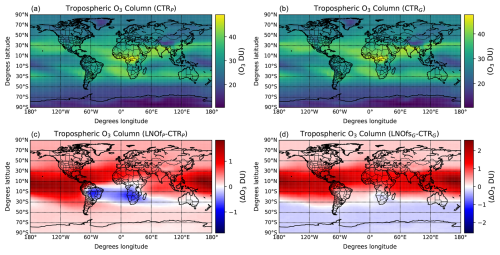
Figure 6Global tropospheric column of O3 in the CTR simulations (a, b) and differences in the O3 total column (integrated between the ground and the top of the troposphere) between the LNOfs and CTR simulations (c, d) averaged during DJF (2002–2007). The values are given in Dobson Units (DU). The subscript indicates the lightning parameterization: P represents Price and Rind (1992) and G represents Grewe et al. (2001). The monthly total O3 column from the CTRL simulation can be seen in Figs. S3–S14.

Figure 7Global tropospheric column of O3 in the CTR simulations (a, b) and differences in the O3 total column (integrated between the ground and the top of the troposphere) between the LNOfs and CTR simulations (c, d) averaged during MAM (2002–2007). The values are given in Dobson Units (DU). The subscript indicates the lightning parameterization: P represents Price and Rind (1992) and G represents Grewe et al. (2001). The monthly total O3 column from the CTRL simulation can be seen in Figs. S3–S14.
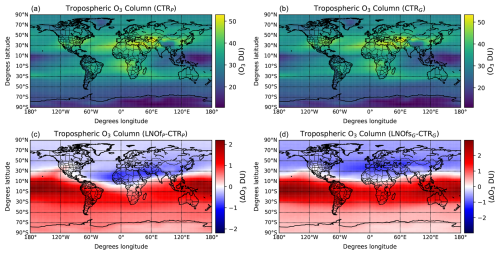
Figure 8Global tropospheric column of O3 in the CTR simulations (a, b) and differences in the O3 total column (integrated between the ground and the top of the troposphere) between the LNOfs and CTR simulations (c, d) averaged during JJA (2002–2007). The values are given in Dobson Units (DU). The subscript indicates the lightning parameterization: P represents Price and Rind (1992) and G represents Grewe et al. (2001). The monthly total O3 column from the CTRL simulation can be seen in Figs. S3–S14.
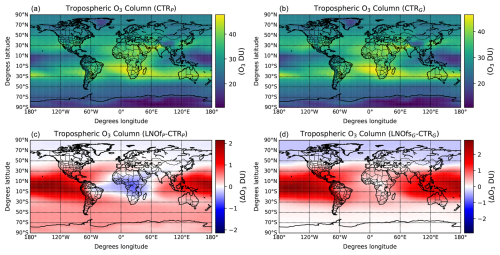
Figure 9Global tropospheric column of O3 in the CTR simulations (a, b) and differences in the O3 total column (integrated between the ground and the top of the troposphere) between the LNOfs and CTR simulations (c, d) averaged during SON (2002–2007). The values are given in Dobson Units (DU). The subscript indicates the lightning parameterization: P represents Price and Rind (1992) and G represents Grewe et al. (2001). The monthly total O3 column from the CTRL simulation can be seen in Figs. S3–S14.
The relationship between HOx and LNOx is not linear (Schumann and Huntrieser, 2007). Under clean-air conditions and in medium-polluted regions, OH is produced as a consequence of LNOx by O3 and NO2 photolysis. However, in regions with large amounts of NOx, LNOx contributes to a depletion of the HO2 mixing ratio by reactions between NO2 and HO2, contributing to a decrease in the HOx mixing ratio. At the 600 hPa level (Figs. S3–S5), where in general the background NOx is low, increases of NOx lead to increases of HOx (Figs 5d–i and S3–S5). We obtain the opposite situation at the 200 hPa level, where the background NOx is large (Figs 5d-i and S9–S11). At the 400 hPa pressure level, where the background NOx is medium in comparison with other vertical levels (Fig. 4)g, the relationship between NOx and HOx is more complex (Figs. 5d-i and S6–S8).
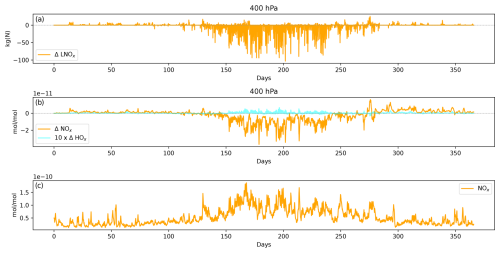
Figure 10(a) Difference in the hourly total column production of LNOx between the LNOfsL and CTRL simulations over a 1-year period (day 1 corresponds to 1 January 2000). (b) Hourly differences in the mixing ratios of NOx and HOx at the 400 hPa. (c) Hourly background mixing ratio of NOx at the 400 hPa level in the LNOfsL simulation. The three panels correspond to a spatial average over Europe (bounded by 42 to 52° N latitude and by 0 to 24° E longitude). The subscript P indicates the lightning parameterization: Price and Rind (1992).
To exemplify the influence of LNOx on the mixing ratio of HOx, we show the impact of LNOx on the HOx mixing ratio in the geographical region of Europe (bounded by 42 to 52° N latitude and by 0 to 24° E longitude) in Fig. 10. The first panel illustrates the disparity in the hourly total column emissions of LNOx between the LNOfsL and CTRL simulations over a 1-year period, where negative values represent a reduced LNOx production in the LNOfsL simulation. In the second panel, the hourly differences in the NOx and HOx mixing ratios at the 400 hPa level are shown. Lastly, the third panel shows the hourly background mixing ratio of NOx at the 400 hPa level. Before day 140, when the background mixing ratio of NOx is low, changes in NOx and HOx follow the same trend. Conversely, during the summer when the background mixing ratio of NOx is large, the changes in NOx and HOx are of opposite signs, implying that increased NOx leads to a decrease in the mixing ratio of HOx.
Table 2Annually averaged tropospheric methane lifetime with respect to OH () in years and standard deviation resulting from different simulation results.

In Figs. S12 and S13, we show analogous plots to Fig. 10 but at different pressure levels (200 and 600 hPa, respectively). At the 200 hPa level, characterized by a large background mixing ratio of NOx (see Fig. 4g), the changes in NOx and HOx exhibit opposing behaviours. Conversely, at the 600 hPa level, where the background mixing ratio of NOx is low (see Fig. 4g), the changes in NOx and HOx follow the same trend. In turn, we gather the background mixing ratio of NOx across each cell domain at 200, 400, and 600 hPa pressure levels during hours when the changes in NOx and HOx share the same sign, resulting in an average mixing ratio of NOx at 7.2 × 10−11 mol mol−1. Conversely, when the changes in NOx and HOx are of opposite signs, the averaged mixing ratio of NOx is 1.8 × 10−10 mol mol−1. The observed disparity of the NOx background mixing ratio under conditions of opposite sign changes confirms that the influence of LNOx on the mixing ratio of HOx is largely dependent on the background mixing ratio of NOx. Additional details regarding the distribution of the background mixing ratio of NOx under similar or opposite sign variations are shown in the Supplement.
Figures 4m–o and 5a–c show a clear inverse correlation between the variation of OH and CO, given that the CO in the troposphere is removed by OH through
The differences between the mixing ratios of HNO3 and HNO4 between the simulations can all be explained by the differences in NOx. In the troposphere, LNOx contributes to the production of HNO3 and HNO4. Therefore, in the LNOfs simulations, smaller mixing ratios of NOx in the upper troposphere lead to lower mixing ratios of these species (Fig. 5j–o). The global annual means shown in Figs. S3–S11e and f indicate that the reduction of HNO3 and HNO4 in the LNOfs simulations is larger in the upper troposphere over land, while increased mixing ratios are located over ocean.
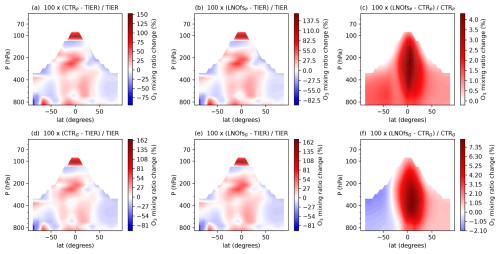
Figure 11Seasonally (DJF) and zonally averaged differences (in %) in the vertical O3 mixing ratio between the simulations and the Bodeker Scientific global vertically resolved ozone database Tier 1.4 vn1.0 product Hassler et al. (2009). The border with the white region represents the zonally averaged mean altitude of the climatological tropopause. The subscript indicates the lightning parameterization: P represents Price and Rind (1992) and G represents Grewe et al. (2001).
The OH radical is a significant oxidant that reacts with methane (CH4), influencing its atmospheric lifetime. Therefore, variations in the mixing ratio of OH caused by different parameterizations of LNOx production can potentially affect the lifetime of CH4. We calculate the tropospheric lifetime of CH4 with respect to OH () on a monthly basis using Jöckel et al. (2016, Eq. 1). Table 2 shows the annually averaged tropospheric methane lifetime with respect to OH resulting from different simulations, together with the standard deviation. To calculate the means shown in Table2, we first compute the mean for each simulated year based on the monthly means of the 12 months. Then, we calculate the overall mean and standard deviation as the average and the standard deviation of the yearly means. At a global scale, the annually averaged lifetime of methane with respect to OH in the LNOfs simulations is reduced by 2.2 %, 3.4 %, and 0.7 % for the lightning parameterizations P, G, and L, respectively. We use the mean and standard deviation to compute the p value of a two-sample t test to assess the significance of differences in methane lifetime. A p value threshold of 0.05 is used to determine statistical significance. The results indicate that the differences between CTR and LNOfs are significant in the P and G simulations, with p values of 3 × 10−3 and 10−5, respectively. In contrast, no significant differences are observed in the L simulations, as the obtained p value is 0.2. In the Northern Hemisphere, the corresponding decreases are 2.5 %, 6.2 %, and 1.2 %, respectively. In turn, we obtain decreases of 3.5 %, 2.2 %, and 1.5 % in the Southern Hemisphere. The decreases are larger in the Southern Hemisphere, where more LNOx is emitted due to the larger oceanic area than in the Northern Hemisphere. The new parameterization of the LNOx production affects the lifetime of methane in the P and the G simulations more than in the L simulations. The reduction of the global methane lifetime with respect to OH deviates from that obtained by the multimodel mean of 9.7 ± 1.5 years (Naik et al., 2013).
3.3 Comparison with data of zonal ozone distribution
The simulated zonal ozone distribution from the CTR and LNOfs simulations can be compared with ozone profile data from Hassler et al. (2009) and Bodeker (2014), as previously carried out by Luhar et al. (2021), to assess the impact of different lightning parameterizations on global ozone mixing ratios. The Bodeker Scientific global vertically resolved ozone database includes monthly mean vertical ozone profiles spanning from 1979 to 2016 across 70 vertical levels. In this study, we utilize the Tier 1.4 vn1.0 product, specifically the version containing the mean annual cycle derived from anthropogenic, natural, and volcanic emissions. We regrid the data to match the resolution of the model. The comparison between the simulated seasonal zonal ozone distribution and the Bodeker Scientific global vertically resolved ozone database Tier 1.4 vn1.0 product between 2002 and 2007 is shown in Figs. 11–14. During all the seasons, the LNOfs simulations produce more tropospheric ozone than the corresponding CTR simulations in the tropics, causing more disagreement with measurements than the CTR simulations. The effect of the LNOfs simulations in the midlatitude tropospheric ozone varies with the lightning parameterization and with the seasons. For DJF, the new parameterization of the production of LNOx produces a larger content of tropospheric ozone in the Northern Hemisphere, contributing to a better agreement with measurements. In the Southern Hemisphere, the LNOfs simulations produce more tropospheric ozone in the P simulations but less ozone in the G simulations, producing a better agreement with the measurements only in the case of the P simulations. For MAM, the LNOfsP simulation shows more ozone in both hemispheres, while the LNOfsG simulations result in more ozone in the tropics but less ozone in the midlatitudes in both hemispheres. In this case, only the LNOfsP simulations show a better agreement with the measurements and only in the Northern Hemisphere. For JJA, the LNOfs simulations result in a better agreement with observations in the Southern Hemisphere, and less agreement in the Northern Hemisphere. For SON, the LNOfs simulations show a better agreement with the measured tropospheric ozone in the Southern Hemisphere and a worse agreement in the Northern Hemisphere.

Figure 12Seasonally (March–April–May, MAM) and zonally averaged differences (in %) in the vertical O3 mixing ratio between the simulations and the Bodeker Scientific global vertically resolved ozone database Tier 1.4 vn1.0 product Hassler et al. (2009). The border with the white region represents the zonally averaged mean altitude of the climatological tropopause. The subscript indicates the lightning parameterization: P represents Price and Rind (1992) and G represents Grewe et al. (2001).
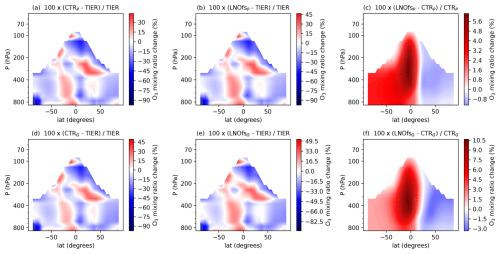
Figure 13Seasonally (JJA) and zonally averaged differences (in %) in the vertical O3 mixing ratio between the simulations and the Bodeker Scientific global vertically resolved ozone database Tier 1.4 vn1.0 product Hassler et al. (2009). The border with the white region represents the zonally averaged mean altitude of the climatological tropopause. The subscript indicates the lightning parameterization: P represents Price and Rind (1992) and G represents Grewe et al. (2001).

Figure 14Seasonally (September–October–November, SON) and zonally averaged differences (in %) in the vertical O3 mixing ratio between the simulations and the Bodeker Scientific global vertically resolved ozone database Tier 1.4 vn1.0 product Hassler et al. (2009). The border with the white region represents the zonally averaged mean altitude of the climatological tropopause. The subscript indicates the lightning parameterization: P represents Price and Rind (1992) and G represents Grewe et al. (2001).
The seasonal variations in the simulated zonal ozone distribution between 2002 and 2007 (Figs. 11–14) can be compared with the corresponding interannual zonally averaged differences in the vertical O3 mixing ratio provided by the Bodeker Scientific global vertically resolved ozone database (Tier 1.4, version 1.0) (Hassler et al., 2009). These differences, calculated relative to the seasonal mean for 2002–2007, are shown in Figs. S26–S29. This comparison aims to evaluate the significance of the observed variations. The seasonal variations between the simulated tropospheric O3 and the Tier 1.4 product are most pronounced in the tropics and the middle troposphere (Figs. 11–14), whereas the interannual variations in the Tier 1.4 product peak in the extratropics and the upper troposphere (Figs. S26–S29). Consequently, we conclude that the differences in tropospheric O3 between the simulation and the Tier 1.4 product are relevant, since they exceed the interannual variability of tropospheric O3.
The interannual zonally averaged differences during each season of the vertical O3 mixing ratio between the annual Bodeker Scientific global vertically resolved ozone database Tier 1.4 vn1.0 product (Hassler et al., 2009) and the annual mean during the period 2002–2007 for each season are shown in Figs. S26–S29.
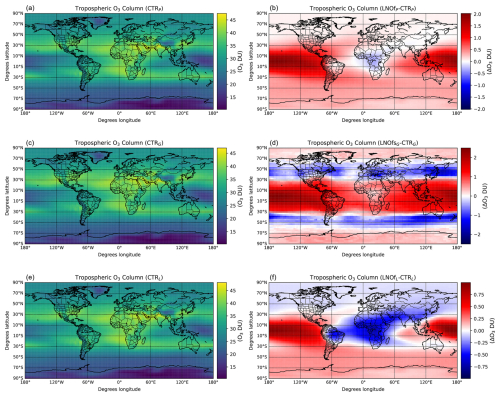
Figure 15Annually (2002–2007) and globally averaged tropospheric column of O3 in the CTR simulations (a, c, and e) and differences in the O3 total column (integrated between the ground and the top of the troposphere) between the LNOfs and CTR simulations (b, d, and f). The values are given in Dobson Units (DU). The subscript indicates the lightning parameterization: P represents Price and Rind (1992), G represents Grewe et al. (2001), and L represents Luhar et al. (2021) (see Table 1). The monthly total O3 column from the CTRG simulation can be seen in Figs. S14–S25.
Jöckel et al. (2016, Fig. 29) compared the annual tropospheric partial column of ozone from the RC1-base-07 simulation with AURA Microwave Limb Sounder/Ozone Monitoring Instrument (MLS/OMI; Ziemke et al., 2011) measurements (reproduced in Fig. S30), obtaining an overestimation of ozone in the tropics, especially over Africa, Indonesia, and the Indian Ocean. In turn, the RC1-base-07 simulation produced an underestimation of the tropospheric partial column of ozone below about 50° S latitude. We show in Fig. 15 a comparison of the annual-averaged tropospheric partial column of ozone between the CTR and LNOfs simulations. The LNOfs simulations with the parameterizations based on the CTH (LNOfsP and LNOfsL) produce a smaller tropospheric column of ozone in tropical Africa compared to the CTR parameterizations, resulting in a better agreement with measurements (Jöckel et al., 2016, Fig. 29). In turn, LNOfsP and LNOfsL produce a larger column of tropospheric ozone below 50° S latitude than the CTR simulations, leading to a better agreement with measurements. The LNOfsL simulation results in a smaller column of tropospheric ozone above 50° N latitude, showing again a better agreement with observations. However, the obtained overestimation of tropospheric ozone over the tropical oceans disagrees more with the measurements. In the case of the G simulations, the LNOfsG simulation produces a better agreement with measurements above 30° N latitude than the CTRG simulation but less agreement over the rest of the globe.
3.4 Limitations and uncertainties
In this study, we examine the impact on atmospheric chemistry of parameterizing LNOx production based on lightning frequency. In particular, we use the global relationship between LNOx production and flash frequency as derived by Bucsela et al. (2019, Fig. 11c). While substantial evidence exists, suggesting possible relationships between LNOx production per flash and flash frequency (Bucsela et al., 2019; Allen et al., 2019, 2021; Zhang et al., 2022; Pérez-Invernón et al., 2023b; Pickering et al., 2024), quantifying this relationship on a global scale using satellite-based data and global lightning measurements remains challenging and uncertain, as discussed by Bucsela et al. (2019). Firstly, it is important to emphasize that the relationship provided by Bucsela et al. (2019) was derived over midlatitude land regions, but it is applied globally in this study. However, Allen et al. (2019) used a similar method to derive LNOx PE within the tropics (including oceans), finding that tropical PE is only 10 % lower than the midlatitude PE derived by Bucsela et al. (2019). In addition, Allen et al. (2019) reported evidence for a decrease in LNOx PE with increasing flash rate on a regional basis within the tropics.
The low detection efficiency of WWLLN in some regions (Holzworth et al., 2009) together with the uncertainty in satellite-based vertical column density of NOx introduce a large uncertainty in the estimated LNOx production. Bucsela et al. (2021) used TROPOMI NO2 and cloud measurements together with GLM lightning data to improve the estimation of LNOx production. They reported that the relationship between the production of LNOx per flash and the flash frequency for thunderstorms producing less than 3000 flashes per hour and degree in America (98 % of all the analysed cases) could be weaker than the relationship reported by Bucsela et al. (2019). Therefore, the results obtained in this study should be regarded as the upper limit of the impact that an LNOx production parameterization based on lightning flash frequency may have on the chemical composition of the atmosphere.
For the first time, a parameterization of LNOx production, based on the flash frequency, is introduced in the climate–chemistry model EMAC. This LNOx parameterization is based on OMI NO2 measurements provided by Bucsela et al. (2019), who reported an inverse relationship between the lightning flash frequency in thunderstorms and the production of LNOx per flash. Although more recent studies have reported a weaker relationship between the production of LNOx per flash and the flash frequency in America (Bucsela et al., 2021), there are no new estimates of this relationship on a global scale. Therefore, the results obtained in this study should be considered the upper limit of the impact that an LNOx production parameterization based on lightning flash frequency could have on atmospheric chemical composition. Three pairs of 8-year simulations by using three different lightning parameterizations (Price and Rind, 1992; Grewe et al., 2001; Luhar et al., 2021) enable us to investigate the influence of this LNOx production parameterization for the mixing ratios of NOx = NO + NO2, O3, CO, HOx = H + OH + HO2, N2O, HNO3, and HNO4 in the troposphere.
Based on our findings, the LNOx production parameterization based on the lightning flash frequency leads to an enhanced production of LNOx in thunderstorms with lower flash rates compared to those that impose a constant LNOx production rate per flash. This increase in LNOx production in weaker thunderstorms results in less LNOx over land and more over the oceans. In turn, more LNOx is emitted in winter thunderstorms than in summer thunderstorms. In general, the simulations with the new parameterization of the LNOx production lead to a spatial distribution of LNOx that is more homogeneously distributed over the globe than the simulations with a constant LNOx production per flash (Fig. 3). As a result, we obtain a larger tropospheric column of ozone over the tropical ocean (Figs. 6–9). The influence of the new LNOx production parameterization on tropospheric ozone in other regions of the globe depends on the employed lightning flash frequency parameterization. For the lightning flash frequency parameterizations based on the CTH (Price and Rind, 1992; Luhar et al., 2021), we obtain a smaller tropospheric column of ozone over tropical Africa. In the case of the lightning parameterization based on the upward flux of mass (Grewe et al., 2001), we obtain a smaller column of tropospheric ozone at midlatitudes in the Northern Hemisphere. The maximum change of the tropospheric ozone mixing ratio when using the new scheme is of the order of ∼ 3 %, with the lowest variations in the case of the lightning parameterization by Luhar et al. (2021), which already included a modification of lightning frequency over oceans.
The oxidation capacity of the atmosphere is influenced by the new LNOx production parameterization, as tropospheric NOx plays an important role in the chemical budget of tropospheric HOx. In particular, we obtain a global decrease in the tropospheric lifetime of methane with respect to OH ranging between 0.7 % and 3.4 %, especially over the Southern Hemisphere.
The new parameterization of the production of LNOx leads to a decrease in tropospheric CO by about 2 % worldwide, reaching its maximum over the tropical oceans. The mixing ratio of tropospheric HNO3 is reduced up to 8 % globally, especially over land. Finally, we obtain an increase in the tropospheric HNO4 mixing ratio of about 4 %, with significant increases over ocean and decreases over land.
These findings highlight the importance of understanding the variability of LNOx production to enhance the chemical budget of key trace gas species in climate–chemistry models. Geostationary satellite measurements of NO2 have the potential to significantly contribute to more accurate LNOx production parameterizations. Examples of such satellites include the Geostationary Environment Monitoring Spectrometer (GEMS, launched in February 2020; Kim et al., 2020), the Tropospheric Emissions: Monitoring of Pollution (TEMPO, launched in April 2023; Zoogman et al., 2017), and the Meteosat Third Generation (MTG) imaging and sounding satellites (Holmlund et al., 2021). In particular, continuous (1 hourly) measurements of NO2 provided by geostationary satellites over an area can offer unprecedented insight into the temporal evolution of LNOx in thunderstorms at a quasi-global scale, revealing the relationships between LNOx production per flash and thunderstorm evolution.
The data of the simulations generated in this study have been deposited in the Zenodo repository (https://doi.org/10.5281/zenodo.13968463, Pérez-Invernón et al., 2024). The Modular Earth Submodel System (MESSy) (https://doi.org/10.5281/zenodo.8360276, MESSy-Consortium, 2021) is continuously developed and applied by a consortium of institutions. The usage of MESSy and access to the source code are licensed to all affiliates of institutions which are members of the MESSy Consortium. Institutions can become a member of the MESSy Consortium by signing the MESSy Memorandum of Understanding. More information can be found on the MESSy Consortium website (http://www.messy-interface.org, MESSy-Consortium, 2025). As the MESSy code is only available under license, the code cannot be made publicly available. The parameterization of LNOx production has been developed based on MESSy version 2.55.
The supplement related to this article is available online at https://doi.org/10.5194/acp-25-5557-2025-supplement.
FJPI: conceptualization, methodology, validation, formal analysis, investigation, data curation, writing (original draft). FJGV, HH, and PJ: conceptualization, methodology, validation, formal analysis, investigation, data curation, writing (review and editing). EJB: conceptualization, investigation, writing (review and editing).
At least one of the (co-)authors is a member of the editorial board of Atmospheric Chemistry and Physics. The peer-review process was guided by an independent editor, and the authors also have no other competing interests to declare.
The content of the paper is the sole responsibility of the author(s) and does not represent the opinion of the Helmholtz Association, and the Helmholtz Association is not responsible for any use that might be made of the information contained.
Publisher's note: Copernicus Publications remains neutral with regard to jurisdictional claims made in the text, published maps, institutional affiliations, or any other geographical representation in this paper. While Copernicus Publications makes every effort to include appropriate place names, the final responsibility lies with the authors. Regarding the maps used in this paper, please note that Figs. 2, 3, 6–9, and 15 contain disputed territories.
This article is part of the special issue “The Modular Earth Submodel System (MESSy) (ACP/GMD inter-journal SI)”. It is not associated with a conference.
The high-performance computing (HPC) simulations have been carried out on the DRAGO supercomputer of CSIC.
The project that gave rise to these results received the support of a fellowship from “la Caixa” Foundation (ID 100010434). The fellowship code is LCF/BQ/PI22/11910026 (Francisco J. Pérez-Invernón). In addition, this study is part of the project RYC2022-035821-I, funded by MCIN/AEI/10.13039/501100011033 and FSE+ (Francisco J. Pérez-Invernón). Additionally, this work was supported by grant PID2022-136348NB-C31, funded by MCIN/AEI/10.13039/501100011033 and “ERDF A way of making Europe”. Francisco J. Pérez-Invernón and Francisco J. Gordillo-Vázquez were supported by grant CEX2021-001131-S, funded by MCIN/AEI/10.13039/501100011033. Patrick Jöckel was supported by the Initiative and Networking Fund of the Helmholtz Association through the project “Advanced Earth System Modelling Capacity (ESM)” and from the Helmholtz Association project “Joint Lab Exascale Earth System Modelling (JL-ExaESM)”.
The article processing charges for this open-access publication were covered by the CSIC Open Access Publication Support Initiative through its Unit of Information Resources for Research (URICI).
This paper was edited by Pedro Jimenez-Guerrero and reviewed by two anonymous referees.
Allen, D., Pickering, K. E., Bucsela, E., Van Geffen, J., Lapierre, J., Koshak, W., and Eskes, H.: Observations of Lightning NOx Production From Tropospheric Monitoring Instrument Case Studies Over the United States, J. Geophys. Res.-Atmos., 126, e2020JD034174, https://doi.org/10.1029/2020JD034174, 2021. a, b, c
Allen, D. J. and Pickering, K. E.: Evaluation of lightning flash rate parameterizations for use in a global chemical transport model, J. Geophys. Res.-Atmos., 107, ACH 15-1–ACH 15-21, https://doi.org/10.1029/2002JD002066, 2002. a, b
Allen, D. J., Pickering, K. E., Bucsela, E., Krotkov, N., and Holzworth, R.: Lightning NOx production in the tropics as determined using OMI NO2 retrievals and WWLLN stroke data, J. Geophys. Res.-Atmos., 124, 13498–13518, https://doi.org/10.1029/2018JD029824, 2019. a, b, c, d, e
Bodeker, G.: Bodeker Scientific vertical ozone profile - mixing ratio, NCAS British Atmospheric Data Centre, https://catalogue.ceda.ac.uk/uuid/11e34b5469d4813c02b31c5364995aa6 (last access: 27 June 2024), 2014. a
Bruning, E. C. and MacGorman, D. R.: Theory and observations of controls on lightning flash size spectra, J. Atmos. Sci., 70, 4012–4029, https://doi.org/10.1175/JAS-D-12-0289.1, 2013. a
Bucsela, E., Pickering, K., Allen, D., Loyola, D., Eskes, H., Veefkind, P., van Geffen, J., Koshak, W., and Krotkov, N.: Improved Lightning NOx Production Estimates Using TROPOMI and GLM Data, AGU Fall Meeting 2021, New Orleans, LA, 13–17 December 2021, A24E–07, https://ui.adsabs.harvard.edu/abs/2021AGUFM.A24E..07B/abstract (last acces: 28 May 2025), 2021. a, b, c, d
Bucsela, E. J., Pickering, K. E., Allen, D. J., Holzworth, R. H., and Krotkov, N. A.: Midlatitude lightning NOx production efficiency inferred from OMI and WWLLN data, J. Geophys. Res.-Atmos., 124, 13475–13497, https://doi.org/10.1029/2019JD030561, 2019. a, b, c, d, e, f, g, h, i, j, k, l, m, n, o, p, q, r, s, t, u, v, w, x, y, z, aa
Cecil, D. J., Buechler, D. E., and Blakeslee, R. J.: Gridded lightning climatology from TRMM-LIS and OTD: Dataset description, Atmos. Res., 135, 404–414, https://doi.org/10.1016/j.atmosres.2012.06.028, 2014. a
Christian, H. J., Blakeslee, R. J., Boccippio, D. J., Boeck, W. L., Buechler, D. E., Driscoll, K. T., Goodman, S. J., Hall, J. M., Koshak, J. M., Mach, D. M., and Stewart, M. F.: Global frequency and distribution of lightning as observed from space by the Optical Transient Detector, J. Geophys. Res., 108, ACL 4-1–ACL 4-15, https://doi.org/10.1029/2002JD002347, 2003. a
Crutzen, P. J.: The role of NO and NO2 in the chemistry of the troposphere and stratosphere, Annu. Rev. Earth Pl. Sc., 7, 443–472, 1979. a
Deckert, R., Jöckel, P., Grewe, V., Gottschaldt, K.-D., and Hoor, P.: A quasi chemistry-transport model mode for EMAC, Geosci. Model Dev., 4, 195–206, https://doi.org/10.5194/gmd-4-195-2011, 2011. a
Gordillo-Vázquez, F. J., Pérez-Invernón, F. J., Huntrieser, H., and Smith, A. K.: Comparison of Six Lightning Parameterizations in CAM5 and the Impact on Global Atmospheric Chemistry, Earth Space Sci., 6, 2317–2346, https://doi.org/10.1029/2019EA000873, 2019. a, b, c, d
Grewe, V., Brunner, D., Dameris, M., Grenfell, J., Hein, R., Shindell, D., and Staehelin, J.: Origin and variability of upper tropospheric nitrogen oxides and ozone at northern mid-latitudes, Atmos. Environ., 35, 3421–3433, https://doi.org/10.1016/S1352-2310(01)00134-0, 2001. a, b, c, d, e, f, g, h, i, j, k, l, m, n, o, p, q, r, s, t, u, v
Hassler, B., Bodeker, G., Cionni, I., and Dameris, M.: A vertically resolved, monthly mean, ozone database from 1979 to 2100 for constraining global climate model simulations, Int. J. Remote Sens., 30, 4009–4018, 2009. a, b, c, d, e, f, g
Holmlund, K., Grandell, J., Schmetz, J., Stuhlmann, R., Bojkov, B., Munro, R., Lekouara, M., Coppens, D., Viticchie, B., August, T., Theodore, B., Watts, P., Dobber, M., Fowler, G., Bojinski, S., Schmid, A., Salonen, K., Tjemkes, S., Aminou, D., and Blythe, P.: Meteosat Third Generation (MTG): Continuation and innovation of observations from geostationary orbit, B. Am. Meteorol. Soc., 102, E990–E1015, https://doi.org/10.1175/BAMS-D-19-0304.1, 2021. a
Holzworth, R. H., Rodger, C. J., Brundell, J., Jacobson, A. R., Lay, E. H., Thomas, J. N., and Weinman, J. A.: The World Wide Lightning Location Network (WWLLN): A Review and Update on Global Lightning Research, AGU Fall Meeting Abstracts, San Francisco, CA, 14–18 December 2009, pp. A6+, https://ui.adsabs.harvard.edu/abs/2009AGUFMAE32A..06H/abstract (last access: 28 May 2025), 2009. a
Huntrieser, H., Schumann, U., Schlager, H., Höller, H., Giez, A., Betz, H.-D., Brunner, D., Forster, C., Pinto Jr., O., and Calheiros, R.: Lightning activity in Brazilian thunderstorms during TROCCINOX: implications for NOx production, Atmos. Chem. Phys., 8, 921–953, https://doi.org/10.5194/acp-8-921-2008, 2008. a
Jöckel, P., Tost, H., Pozzer, A., Kunze, M., Kirner, O., Brenninkmeijer, C. A. M., Brinkop, S., Cai, D. S., Dyroff, C., Eckstein, J., Frank, F., Garny, H., Gottschaldt, K.-D., Graf, P., Grewe, V., Kerkweg, A., Kern, B., Matthes, S., Mertens, M., Meul, S., Neumaier, M., Nützel, M., Oberländer-Hayn, S., Ruhnke, R., Runde, T., Sander, R., Scharffe, D., and Zahn, A.: Earth System Chemistry integrated Modelling (ESCiMo) with the Modular Earth Submodel System (MESSy) version 2.51, Geosci. Model Dev., 9, 1153–1200, https://doi.org/10.5194/gmd-9-1153-2016, 2016. a, b, c, d, e, f, g, h
Kang, D., Pickering, K. E., Allen, D. J., Foley, K. M., Wong, D. C., Mathur, R., and Roselle, S. J.: Simulating lightning NO production in CMAQv5.2: evolution of scientific updates, Geosci. Model Dev., 12, 3071–3083, https://doi.org/10.5194/gmd-12-3071-2019, 2019. a
Kim, J., Jeong, U., Ahn, M.-H., Kim, J. H., Park, R. J., Lee, H., Song, C. H., Choi, Y.-S., Lee, K.-H., Yoo, J.-M., Jeong, M.-J., Park, S. K., Lee, K.-M., Song, C.-K., Kim, S.-W., Kim, Y. J., Kim, S.-W., Kim, M., Go, S., Liu, X., Chance, K., Miller, C. C., Al-Saadi, J., Veihelmann, B., Bhartia, P. K., Torres, O., González Abad, G., Haffner, D. P., Ko, D. H., Lee, S. H., Woo, J.-H., Chong, H., Park, S. S., Nicks, D., Choi, W. J., Moon, K.-J., Cho, A., Yoon, J., Kim, S.-K., Hong, H., Lee, K., Lee, H., Lee, S., Choi, M., Veefkind, P., Levelt, P. F., Edwards, D. P., Kang, M., Eo, M., Bak, J., Baek, K., Kwon, H.-A., Yang, J., Park, J., Han, K. M., Kim, B.-R., Shin, H.-W., Choi, H., Lee, E., Chong, J., Cha, Y., Koo, J.-H., Irie, H., Hayashida, S., Kasai, Y., Kanaya, Y., Liu, C., Lin, J., Crawford, J. H., Carmichael, G. R., Newchurch, M. J., Lefer, B. L., Herman, J. R., Swap, R. J., Lau, A. K. H., Kurosu, T. P., Jaross, G., Ahlers, B., Dobber, M., McElroy, C. T., and Choi, Y.: New era of air quality monitoring from space: Geostationary Environment Monitoring Spectrometer (GEMS), B. Am. Meteorol. Soc., 101, E1–E22, https://doi.org/10.1175/BAMS-D-18-0013.1, 2020. a
Koshak, W., Peterson, H., Biazar, A., Khan, M., and Wang, L.: The NASA Lightning Nitrogen Oxides Model (LNOM): application to air quality modeling, Atmos. Res., 135, 363–369, https://doi.org/10.1016/j.atmosres.2012.12.015, 2014. a
Levine, J. S., Augustsson, T. R., Andersont, I. C., Hoell Jr, J. M., and Brewer, D. A.: Tropospheric sources of NOx: Lightning and biology, Atmos. Environ., 18, 1797–1804, https://doi.org/10.1016/0004-6981(84)90355-X, 1984. a, b, c
Liu, S. C.: Possible effects on fropospheric O3 and OH due to NO emissions, Geophys. Res. Lett., 4, 325–328, https://doi.org/10.1029/GL004i008p00325, 1977. a
Luhar, A. K., Galbally, I. E., Woodhouse, M. T., and Abraham, N. L.: Assessing and improving cloud-height-based parameterisations of global lightning flash rate, and their impact on lightning-produced NOx and tropospheric composition in a chemistry–climate model, Atmos. Chem. Phys., 21, 7053–7082, https://doi.org/10.5194/acp-21-7053-2021, 2021. a, b, c, d, e, f, g, h, i, j, k, l, m, n, o, p, q
MESSy-Consortium: The Modular Earth Submodel System, Version 2.55.2, Zenodo [code], https://doi.org/10.5281/zenodo.8360276, 2021. a
MESSy-Consortium: The Modular Earth Submodel System, http://www.messy-interface.org, last access: 10 February 2025. a
Murray, L. T., Jacob, D. J., Logan, J. A., Hudman, R. C., and Koshak, W. J.: Optimized regional and interannual variability of lightning in a global chemical transport model constrained by LIS/OTD satellite data, J. Geophys. Res.-Atmos., 117, D20307, https://doi.org/10.1029/2012JD017934, 2012. a, b, c
Naik, V., Voulgarakis, A., Fiore, A. M., Horowitz, L. W., Lamarque, J.-F., Lin, M., Prather, M. J., Young, P. J., Bergmann, D., Cameron-Smith, P. J., Cionni, I., Collins, W. J., Dalsøren, S. B., Doherty, R., Eyring, V., Faluvegi, G., Folberth, G. A., Josse, B., Lee, Y. H., MacKenzie, I. A., Nagashima, T., van Noije, T. P. C., Plummer, D. A., Righi, M., Rumbold, S. T., Skeie, R., Shindell, D. T., Stevenson, D. S., Strode, S., Sudo, K., Szopa, S., and Zeng, G.: Preindustrial to present-day changes in tropospheric hydroxyl radical and methane lifetime from the Atmospheric Chemistry and Climate Model Intercomparison Project (ACCMIP), Atmos. Chem. Phys., 13, 5277–5298, https://doi.org/10.5194/acp-13-5277-2013, 2013. a
Ott, L. E., Pickering, K. E., Stenchikov, G. L., Allen, D. J., DeCaria, A. J., Ridley, B., Lin, R.-F., Lang, S., and Tao, W.-K.: Production of lightning NOx and its vertical distribution calculated from three-dimensional cloud-scale chemical transport model simulations, J. Geophys. Res.-Atmos., 115, D04301, https://doi.org/10.1029/2009JD011880, 2010. a
Pérez-Invernón, F. J., Huntrieser, H., Erbertseder, T., Loyola, D., Valks, P., Liu, S., Allen, D. J., Pickering, K. E., Bucsela, E. J., Jöckel, P, van Geffen, J., Eskes, H., Soler, S., Gordillo-Vázquez, F. J., and Lapierre, J.: Quantification of lightning-produced NOx over the Pyrenees and the Ebro Valley by using different TROPOMI-NO2 and cloud research products, Atmos. Meas. Tech., 15, 3329–3351, https://doi.org/10.5194/amt-15-3329-2022, 2022a. a
Pérez-Invernón, F. J., Huntrieser, H., Jöckel, P., and Gordillo-Vázquez, F. J.: A parameterization of long-continuing-current (LCC) lightning in the lightning submodel LNOX (version 3.0) of the Modular Earth Submodel System (MESSy, version 2.54), Geosci. Model Dev., 15, 1545–1565, https://doi.org/10.5194/gmd-15-1545-2022, 2022b. a
Pérez-Invernón, F. J., Gordillo-Vázquez, F. J., Huntrieser, H., and Jöckel, P.: Variation of lightning-ignited wildfire patterns under climate change, N at. Commun., 14, 739, https://doi.org/10.1038/s41467-023-36500-5, 2023a. a
Pérez-Invernón, F. J., Gordillo-Vázquez, F. J., van der Velde, O., Montanyá, J., López Trujillo, J. A., Pineda, N., Huntrieser, H., Valks, P., Loyola, D., Seo, S., and Erbertseder, T.: Lightning-Produced Nitrogen Oxides Per Flash Length Obtained by Using TROPOMI Observations and the Ebro Lightning Mapping Array, Geophys. Res. Lett., 50, e2023GL104699, https://doi.org/10.1029/2023GL104699, 2023b. a, b
Pérez-Invernón, F. J., Gordillo-Vázquez, F. J., Huntrieser, H., Jöckel, P., and Bucsela, E.: Monthly averaged lightning and trace gases data extracted from EMAC simulations (2007, T42L90MA resolution), Zenodo [data set], https://doi.org/10.5281/zenodo.13968463, 2024. a
Pickering, K. E., Wang, Y., Tao, W.-K., Price, C., and Müller, J.-F.: Vertical distributions of lightning NOx for use in regional and global chemical transport models, J. Geophys. Res.-Atmos., 103, 31203–31216, https://doi.org/10.1029/98JD02651, 1998. a, b
Pickering, K. E., Bucsela, E., Allen, D., Ring, A., Holzworth, R., and Krotkov, N.: Estimates of lightning NOx production based on OMI NO2 observations over the Gulf of Mexico, J. Geophys. Res.-Atmos., 121, 8668–8691, https://doi.org/10.1002/2015JD024179, 2016. a
Pickering, K. E., Li, Y., Cummings, K. A., Barth, M. C., Allen, D. J., Bruning, E. C., and Pollack, I. B.: Lightning NOx in the 29–30 May 2012 Deep Convective Clouds and Chemistry (DC3) Severe Storm and Its Downwind Chemical Consequences, J. Geophys. Res.-Atmos., 129, e2023JD039439, https://doi.org/10.1029/2023JD039439, 2024. a, b
Price, C. and Rind, D.: A simple lightning parameterization for calculating global lightning distributions, J. Geophys. Res., 97, 9919, https://doi.org/10.1029/92JD00719, 1992. a, b, c, d, e, f, g, h, i, j, k, l, m, n, o, p, q, r, s, t, u, v
Price, C., Penner, J., and Prather, M.: NOx from lightning: 1. Global distribution based on lightning physics, J. Geophys. Res., 102, 5929, https://doi.org/10.1029/96JD03504, 1997. a, b, c, d, e, f, g, h, i, j
Schumann, U. and Huntrieser, H.: The global lightning-induced nitrogen oxides source, Atmos. Chem. Phys., 7, 3823–3907, https://doi.org/10.5194/acp-7-3823-2007, 2007. a, b, c, d, e, f
Stith, J., Dye, J., Ridley, B., Laroche, P., Defer, E., Baumann, K., Hübler, G., Zerr, R., and Venticinque, M.: NO signatures from lightning flashes, J. Geophys. Res.-Atmos., 104, 16081–16089, https://doi.org/10.1029/1999JD900174, 1999. a
Tost, H., Jöckel, P., and Lelieveld, J.: Lightning and convection parameterisations – uncertainties in global modelling, Atmos. Chem. Phys., 7, 4553–4568, https://doi.org/10.5194/acp-7-4553-2007, 2007. a, b, c, d, e, f
Verma, S., Yadava, P. K., Lal, D., Mall, R., Kumar, H., and Payra, S.: Role of lightning NOx in ozone formation: A review, Pure Appl. Geophys., 178, 1425–1443, https://doi.org/10.1007/s00024-021-02710-5, 2021. a
Wang, Y., DeSilva, A., Goldenbaum, G., and Dickerson, R.: Nitric oxide production by simulated lightning: Dependence on current, energy, and pressure, J. Geophys. Res.-Atmos., 103, 19149–19159, https://doi.org/10.1029/98JD01356, 1998. a
Wu, S., Mickley, L. J., Jacob, D. J., Logan, J. A., Yantosca, R. M., and Rind, D.: Why are there large differences between models in global budgets of tropospheric ozone?, J. Geophys. Res.-Atmos., 112, D05302, https://doi.org/10.1029/2006JD007801, 2007. a
Wu, Y., Pour-Biazar, A., Koshak, W. J., and Cheng, P.: LNOx Emission Model for Air Quality and Climate Studies Using Satellite Lightning Mapper Observations, J. Geophys. Res.-Atmos., 128, e2022JD037406, https://doi.org/10.1029/2022JD037406, 2023. a
Zeldovich, Y., Frank-Kamenetskii, D., and Sadovnikov, P.: Oxidation of nitrogen in combustion, Publishing House of the Acad of Sciences of USSR, 1947. a
Zhang, X., Yin, Y., van der A, R., Eskes, H., van Geffen, J., Li, Y., Kuang, X., Lapierre, J. L., Chen, K., Zhen, Z., Hu, J., He, C., Chen, J., Shi, R., Zhang, J., Ye, X., and Chen, H.: Influence of convection on the upper-tropospheric O3 and NOx budget in southeastern China, Atmos. Chem. Phys., 22, 5925–5942, https://doi.org/10.5194/acp-22-5925-2022, 2022. a, b
Ziemke, J. R., Chandra, S., Labow, G. J., Bhartia, P. K., Froidevaux, L., and Witte, J. C.: A global climatology of tropospheric and stratospheric ozone derived from Aura OMI and MLS measurements, Atmos. Chem. Phys., 11, 9237–9251, https://doi.org/10.5194/acp-11-9237-2011, 2011. a
Zoogman, P., Liu, X., Suleiman, R., Pennington, W., Flittner, D., Al-Saadi, J., Hilton, B., Nicks, D., Newchurch, M., Carr, J., Janz, S., Andraschko, M., Arola, A., Baker, B., Canova, B., Chan Miller, C., Cohen, R., Davis, J., Dussault, M., Edwards, D., Fishman, J., Ghulam, A., González Abad, G., Grutter, M., Herman, J., Houck, J., Jacob, D., Joiner, J., Kerridge, B., Kim, J., Krotkov, N., Lamsal, L., Li, C., Lindfors, A., Martin, R., McElroy, C., McLinden, C., Natraj, V., Neil, D., Nowlan, C., O'Sullivan, E., Palmer, P., Pierce, R., Pippin, M., Saiz-Lopez, A., Spurr, R., Szykman, J., Torres, O., Veefkind, J., Veihelmann, B., Wang, H., Wang, J., and Chance, K.: Tropospheric emissions: Monitoring of pollution (TEMPO), J. Quant. Spectrosc. Ra., 186, 17–39, https://doi.org/10.1016/j.jqsrt.2016.05.008, 2017. a




